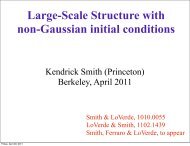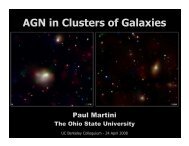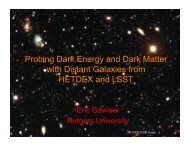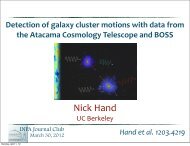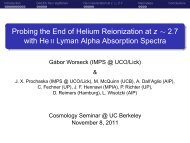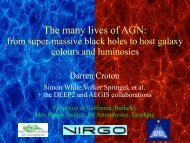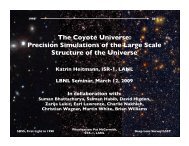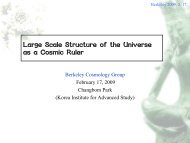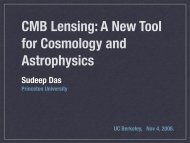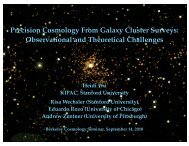Large-scale homogeneity vs. small- scale inhomogeneity: testing ...
Large-scale homogeneity vs. small- scale inhomogeneity: testing ...
Large-scale homogeneity vs. small- scale inhomogeneity: testing ...
Create successful ePaper yourself
Turn your PDF publications into a flip-book with our unique Google optimized e-Paper software.
ICRAR is a partnership between the University of<br />
Western Australia and Curtin University of Technology<br />
<strong>Large</strong>-<strong>scale</strong> <strong>homogeneity</strong> <strong>vs</strong>. <strong>small</strong>-<br />
<strong>scale</strong> in<strong>homogeneity</strong>: <strong>testing</strong> ΛCDM<br />
with large <strong>scale</strong> structure<br />
Lawrence Berkeley National Laboratory, 18 January 2013<br />
Morag Scrimgeour (ICRAR / UWA)<br />
Supervisors: Tamara Davis, Lister Staveley-Smith, Peter Quinn + Chris Blake
Big picture: What is the nature of dark energy?<br />
1. Testing large-<strong>scale</strong> cosmic <strong>homogeneity</strong> with the<br />
WiggleZ Dark Energy Survey<br />
2. Cosmology with Peculiar Velocity Surveys<br />
Outline<br />
01/18/2013 Morag I. Scrimgeour 2
01/18/2013<br />
Testing large-<strong>scale</strong><br />
cosmic <strong>homogeneity</strong> with<br />
the WiggleZ Dark Energy<br />
Survey<br />
Morag I. Scrimgeour 3
• Cosmological principle: Universe is<br />
homogeneous and isotropic<br />
<strong>Large</strong>-<strong>scale</strong> Cosmic Homogeneity<br />
− Homogeneous: different regions of the<br />
Universe have the same mean density<br />
− Isotropic: looks the same in all<br />
directions<br />
• Allows use of Friedmann-Robertson-<br />
Walker (FRW) spacetime metric<br />
• Need FRW to convert redshifts to<br />
distances, via Friedmann eqn:<br />
2<br />
H<br />
2<br />
H0 = ! Ra"4 + ! Ma "3 + ! ka "2 + ! #<br />
01/18/2013<br />
Morag I. Scrimgeour<br />
Springel et al. (2005)<br />
4
In<strong>homogeneity</strong>: alternative to Dark<br />
• Is ‘perturbed FRW’ a valid description?<br />
• <strong>Large</strong> inhomogeneities → breakdown of FRW<br />
01/18/2013<br />
− Light paths distorted: distances inferred from redshifts are<br />
wrong (e.g. Wiltshire 2010)<br />
− “Averaging problem” and<br />
backreaction: different-density<br />
regions evolve differently, can have<br />
global accelerated expansion<br />
without Dark Energy<br />
(e.g. Buchert 2007, Li & Schwarz<br />
2009, Räsänen 2011)<br />
− Void models, e.g. Lemaître-<br />
Tolman-Bondi model<br />
Energy?<br />
Image: hubblesite.org<br />
Morag I. Scrimgeour 5
Even if we have large-<strong>scale</strong><br />
<strong>homogeneity</strong>…<br />
• Statistical tools used to test cosmology (Power Spectrum,<br />
Correlation Function) require <strong>homogeneity</strong> on <strong>scale</strong> of survey<br />
01/18/2013<br />
− Their definition and<br />
calculation requires mean<br />
density (from largest <strong>scale</strong>s<br />
in survey):<br />
P(r) = ! 2 [ 1+"(r) ]dV1dV2 − Mean density undefined<br />
below <strong>scale</strong> of <strong>homogeneity</strong><br />
→ results can be<br />
misleading<br />
− Important to know <strong>scale</strong> of<br />
transition to <strong>homogeneity</strong><br />
WiggleZ correlation function at z=0.6<br />
Blake et al. (2010)<br />
Morag I. Scrimgeour 6
• So far, results are conflicting!<br />
• Homogeneity ~ 70 h -1 Mpc:<br />
SDSS LRGs (Hogg et al. 2005),<br />
SDSS DR1 (Yadav et al. 2005),<br />
SDSS DR6 (Sarkar et al. 2009)<br />
• But several works find fractal<br />
structure up to <strong>scale</strong>s >100<br />
h -1 Mpc - no transition to<br />
<strong>homogeneity</strong> (e.g. Joyce et al.<br />
1999, Sylos Labini et al. 2009)<br />
01/18/2013<br />
Homogeneity in Galaxy Surveys<br />
Image: M.Blanton and the SDSS collaboration<br />
Morag I. Scrimgeour 7
• <strong>Large</strong> (~1Gpc 3 ), deep (z
Fractal (correlation) dimension D 2(r)<br />
• Fractal dimensions quantify clustering<br />
• Correlation dimension D 2(r): related to 2point<br />
correlation function. Based on the<br />
mean value N(
Fractal (correlation) dimension D 2(r)<br />
• Fractal dimensions quantify clustering<br />
• Correlation dimension D 2(r): related to 2point<br />
correlation function. Based on the<br />
mean value N(
01/18/2013<br />
Selection Function Correction<br />
• Ideally, want a complete, volume-limited sample<br />
• In WiggleZ: must correct for selection function using random<br />
catalogues<br />
N(
• Simple relation to<br />
correlation function:<br />
• Number of neighbours is<br />
integral of correlation<br />
function over volume:<br />
• Divide by expected<br />
number for ξ=0, ρV:<br />
01/18/2013<br />
P(r) = " 2 [1+ #(r)]dV 1 dV 2<br />
N(r) = " [1+ b 2 #(s)]4$s 2 %<br />
r<br />
ds<br />
0<br />
N(r) = 3<br />
4"r 3<br />
[1+ b 2 #(s)]4"s 2 $<br />
r<br />
ds<br />
0<br />
Model N(
• In ΛCDM expect:<br />
− Small <strong>scale</strong>s: fractal-like structure<br />
− >100 h -1 Mpc: homogeneous<br />
D 2(r) measurements so far…<br />
• Some D 2 measures: 1.2 – 2.2 on <strong>small</strong> <strong>scale</strong>s, close to 3<br />
above ~ 70 h -1 Mpc (Wu et al. 1999, Yadav et al. 2005 )<br />
• But ‘fractal<br />
proponents’ have<br />
found D 2~2 for <strong>scale</strong>s<br />
up to 150 h -1 Mpc<br />
(Sylos Labini et al. 1998,<br />
Joyce et al. 1999)<br />
• So is the Universe a<br />
fractal?<br />
01/18/2013<br />
Image: www.presidiacreative.com<br />
Morag I. Scrimgeour 13
01/18/2013<br />
0.1
How do we define the “<strong>homogeneity</strong><br />
• Past measurements: see where data comes within 1-sigma of<br />
<strong>homogeneity</strong><br />
<strong>scale</strong>” R H?<br />
• Our method: Fit polynomial to data, take intercept with chosen value<br />
close to <strong>homogeneity</strong><br />
• Uncertainties from 100 lognormal realisations<br />
01/18/2013<br />
Scrimgeour et al. (2012)<br />
Morag I. Scrimgeour 15
01/18/2013<br />
0.1
01/18/2013<br />
0.3
01/18/2013<br />
0.5
01/18/2013<br />
0.7
01/18/2013<br />
ΛCDM D 2(r) model: effect of bias<br />
Low b<br />
High b<br />
Scrimgeour et al. (2012)<br />
Morag I. Scrimgeour 20
01/18/2013<br />
ΛCDM D 2(r) model: effect of bias<br />
Low b<br />
High b<br />
R H increases with b and σ 8<br />
WiggleZ: b increases, σ 8<br />
decreases, with redshift<br />
Scrimgeour et al. (2012)<br />
Morag I. Scrimgeour 21
01/18/2013<br />
D 2(r): All results<br />
Scrimgeour et al. (2012)<br />
Morag I. Scrimgeour 22
Scrimgeour et al. (2012)<br />
01/18/2013<br />
R H as a function of b 2 σ 8 2<br />
Morag I. Scrimgeour 23
0 250 500 750 1000<br />
col3<br />
0 250 500 750 1000<br />
col1<br />
0 250 500 750 1000<br />
col2<br />
Selection function and boundary<br />
condition tests with fractal models<br />
• Generated 100 fractal distributions with D 2 =2.7, 2.8, 2.9<br />
• Sampled with WiggleZ selection function<br />
• Find measured D 2 consistent with input D 2 up to at least 200 h -1 Mpc<br />
01/18/2013<br />
Scrimgeour et al. (2012)<br />
Morag I. Scrimgeour 24
• WiggleZ measurement of<br />
<strong>homogeneity</strong> <strong>scale</strong>:<br />
R H = [71±8, 70±5, 81±5, 75±4]<br />
h -1 Mpc for z~[0.2, 0.4, 0.6, 0.8].<br />
• Results indicate Universe is not<br />
a fractal, does transition to<br />
<strong>homogeneity</strong><br />
Homogeneity Discussion<br />
• Find strong consistency with a FRW-based ΛCDM model<br />
• Complication for all <strong>homogeneity</strong> analyses: only observe<br />
galaxies on past light cone<br />
01/18/2013<br />
− Must assume FRW to convert redshifts to distances.<br />
− Isotropy measurement in z-shells? → Future work<br />
Morag I. Scrimgeour 25
01/18/2013<br />
Cosmology with Peculiar<br />
Velocity Surveys<br />
Morag I. Scrimgeour 26
01/18/2013<br />
What are peculiar velocities?<br />
• Peculiar velocity: the velocity of a galaxy separate<br />
from the Hubble flow<br />
• Due to gravitational interaction with nearby galaxies /<br />
overdensities<br />
Image: University of Oregon<br />
Morag I. Scrimgeour 27
01/18/2013<br />
<strong>Large</strong> Scale Structure in the Local<br />
Morag I. Scrimgeour<br />
Universe<br />
28
01/18/2013<br />
<strong>Large</strong>-<strong>scale</strong> Dark Matter field<br />
Millennium Simulation (Springel et al 2005)<br />
Dark matter cosmological N-body simulation<br />
Morag I. Scrimgeour 29
01/18/2013<br />
Peculiar velocities: tracers of matter<br />
• Provide map of underlying matter field<br />
• Velocity field related to density field via<br />
(assuming linear approximation):<br />
where<br />
− f: growth rate<br />
− γ: growth index<br />
• Unbiased (unlike galaxies)<br />
Morag I. Scrimgeour 30
• Nature of dark energy<br />
− Expansion history H(z)<br />
− Growth of structure f=Ω m (z) γ<br />
• PVs are direct probe of gravity<br />
− Can test General Relativity, modified<br />
gravity<br />
− β=f/b : redshift- space distortion<br />
parameter, from combination of<br />
velocity & density<br />
• Nature of dark matter<br />
− Particle nature<br />
− Nature & evolution of structure<br />
• σ 8 , Ω m constraints<br />
• Tests of backreaction<br />
01/18/2013<br />
Peculiar Velocities as a cosmology<br />
probe I<br />
Image: NASA/WMAP Science team<br />
Morag I. Scrimgeour 32
• Nature of dark energy<br />
− Expansion history H(z)<br />
− Growth of structure f=Ω m (z) γ<br />
• PVs are direct probe of gravity<br />
− Can test General Relativity, modified<br />
gravity<br />
− β=f/b : redshift- space distortion<br />
parameter, from combination of<br />
velocity & density<br />
• Nature of dark matter<br />
− Particle nature<br />
− Nature & evolution of structure<br />
• σ 8 , Ω m constraints<br />
• Tests of backreaction<br />
01/18/2013<br />
Peculiar Velocities as a cosmology<br />
probe I<br />
Image: NASA/WMAP Science team<br />
Morag I. Scrimgeour 33
• Nature of dark energy<br />
Peculiar Velocities as a cosmology<br />
− Expansion history H(z)<br />
− Growth of structure f=Ω m (z) γ<br />
• PVs are direct probe of gravity<br />
− Can test General Relativity, modified<br />
gravity<br />
− β=f/b : redshift- space distortion<br />
parameter, from combination of<br />
velocity & density<br />
• Nature of dark matter<br />
− Particle nature<br />
− Nature & evolution of structure<br />
• σ 8 , Ω m constraints<br />
• Tests of backreaction<br />
01/18/2013<br />
probe I<br />
Image: NASA/WMAP Science team<br />
Morag I. Scrimgeour 34
Advantages<br />
Peculiar Velocities as a Cosmology<br />
• Trace underlying matter field (incl. Dark Matter)<br />
• Independent of galaxy bias<br />
• Complementary to RSDs<br />
• Sensitive to large-<strong>scale</strong> modes<br />
Disadvantages<br />
• <strong>Large</strong> distance errors<br />
• Low redshift only<br />
• Possible systematics<br />
01/18/2013<br />
− Malmquist bias<br />
Image: The Cosmic Perspective (1998)<br />
Probe II<br />
Morag I. Scrimgeour 35
01/18/2013<br />
• Bulk Flow / dipole (Watkins et<br />
al. 2009, Nusser & Davis<br />
2011): (σ 8, Ω m)<br />
• Angular power spectrum /<br />
spherical harmonics of<br />
velocity field (Haugbølle et al.<br />
2007, Hannestad et al. 2008)<br />
(σ 8 , Ω m , Γ)<br />
Velocity field statistics I<br />
Watkins et al. (2009)<br />
Hannestad et al. (2008)<br />
Morag I. Scrimgeour 36
Velocity Field Statistics II<br />
• Velocity correlation function ξ vv (Gordon et al. 2007,<br />
Abate & Lahav 2008) (σ 8, Ω m, γ, H 0?)<br />
• 3D velocity power spectrum<br />
(Burkey & Taylor 2004)<br />
• Comparison with redshift surveys: δ-δ <strong>vs</strong>. v-v (β=f/b, γ)<br />
01/18/2013<br />
• Can cancel cosmic variance (e.g. McDonald & Seljak 2009)<br />
Abate & Lahav (2008)<br />
Morag I. Scrimgeour 37
Bulk flows and dark flows: a problem<br />
• “Bulk flow”: the average velocity over some volume<br />
for ΛCDM?<br />
• Kashlinsky et al. (2008): kSZ effect in clusters,<br />
600-1000 km/s at z~0.3 toward l=283˚±14˚, b=12˚±14˚ (since disproven?)<br />
• Watkins et al. (2009): peculiar velocity surveys,<br />
407±81 km/s on ~100 h -1 Mpc <strong>scale</strong>s toward l=287˚±9˚, b=8˚±6˚<br />
• ΛCDM linear theory: ~190 km/s<br />
01/18/2013<br />
Image: NASA/<br />
Goddard/Kashlinsky et al.<br />
Morag I. Scrimgeour 38
Millennium Simulation ΛCDM Bulk<br />
Flow prediction<br />
• Bulk flow magnitude in 100 Gaussian spheres of radius 50 h -1 Mpc<br />
01/18/2013<br />
(Scrimgeour et al. 2013, in prep)<br />
Morag I. Scrimgeour 39
01/18/2013<br />
Conflicting σ 8 constraints<br />
Measurements of σ 8 from Peculiar Velocities
01/18/2013<br />
Several potential systematics:<br />
• Velocity samples difficult to compare<br />
− Shallow & dense <strong>vs</strong>. deep & sparse<br />
− Distance indicators: SNe, FP, TF<br />
• Partial sky can induce systematic error<br />
• Logarithmic distance errors<br />
• Difficult to compare velocities with density field<br />
Problems for Bulk flow<br />
measurements<br />
Morag I. Scrimgeour 41
01/18/2013<br />
Several potential systematics:<br />
• Velocity samples difficult to compare<br />
− Shallow & dense <strong>vs</strong>. deep & sparse<br />
− Distance indicators: SNe, FP, TF<br />
• Partial sky can induce systematic error<br />
• Logarithmic distance errors<br />
• Difficult to compare velocities with density field<br />
• Need all-sky, deeper peculiar velocity surveys<br />
• Homogeneous selection<br />
• Accurate modelling of systematics<br />
Problems for Bulk flow<br />
measurements<br />
Morag I. Scrimgeour 42
• Widefield ASKAP L-band Legacy All-sky<br />
Blind surveY<br />
• 21cm HI survey<br />
• All southern sky<br />
• z < 0.05<br />
WALLABY Peculiar Velocities<br />
• Westerbork Northern HI Sky Survey<br />
(WNSHS, with Apertif) will provide coverage<br />
>+30° in north<br />
• Photometry from SkyMapper or WISE?<br />
• ~30,000 WALLABY + WNSHS Tully-Fisher<br />
distances<br />
01/18/2013<br />
Morag I. Scrimgeour 43
6dFGS Peculiar Velocities<br />
• Spectroscopic survey of southern sky (17,000 deg 2 )<br />
• Primary sample from 2MASS with K tot < 12.75, also secondary<br />
samples with H < 13.0, J < 13.75, r < 15.6, b < 16.75<br />
• Max z ~ 0.15<br />
• 125,000 redshifts, 9000 FP peculiar velocities<br />
• <strong>Large</strong>st combined redshift and peculiar velocity survey by a<br />
factor of 2<br />
01/18/2013<br />
Morag I. Scrimgeour 44
• Optical widefield automated survey<br />
telescope at Siding Spring<br />
Observatory, Australia<br />
• Supernova Survey (Keller et al<br />
2007):<br />
01/18/2013<br />
− 1250 deg 2 of sky<br />
− ~500 SNe per year<br />
− z
~500 Type Ia SNe over 5 years<br />
(Scrimgeour et al. 2013, in prep)<br />
01/18/2013<br />
Simulating the SkyMapper<br />
Supernova Survey<br />
Morag I. Scrimgeour 46
01/18/2013<br />
Bulk Flows: Minimum Variance<br />
• Watkins et al. (2009), Feldman et al. (2010)<br />
• Bulk flow:<br />
• Different surveys difficult to compare<br />
− Different volumes, geometry, sparseness<br />
• Calculate weights to mimic ‘ideal’ survey geometry<br />
− Minimise variance between measured and ‘ideal’ bulk flow<br />
Weights<br />
Morag I. Scrimgeour 47
01/18/2013<br />
Bulk flow distribution
01/18/2013<br />
Bulk Flows: ΛCDM results for<br />
(Scrimgeour et al. 2013, in prep)<br />
SkyMapper<br />
Morag I. Scrimgeour 49
01/18/2013<br />
True bulk<br />
flow<br />
The ‘residual’ bulk flow
01/18/2013<br />
True bulk<br />
flow<br />
Observed<br />
bulk flow<br />
The ‘residual’ bulk flow
01/18/2013<br />
True bulk<br />
flow<br />
Observed<br />
bulk flow<br />
Residual<br />
The ‘residual’ bulk flow
01/18/2013<br />
Bulk Flow Systematics from partial<br />
100 km/s<br />
sky: tests with SkyMapper<br />
100 km/s<br />
400 km/s<br />
400 km/s<br />
100 km/s<br />
400 km/s<br />
ΛCDM<br />
(Scrimgeour et al. 2013, in prep)<br />
Morag I. Scrimgeour 53
01/18/2013<br />
Bulk Flow Systematics from partial<br />
100 km/s<br />
sky: tests with SkyMapper<br />
100 km/s<br />
400 km/s<br />
400 km/s<br />
100 km/s<br />
400 km/s<br />
ΛCDM<br />
(Scrimgeour et al. 2013, in prep)<br />
Morag I. Scrimgeour 54
01/18/2013<br />
Bulk Flow Systematics from partial<br />
100 km/s<br />
sky: tests with SkyMapper<br />
100 km/s<br />
400 km/s<br />
100 km/s<br />
Even with partial sky<br />
coverage 400 km/s and ~500<br />
SNe, systematics<br />
aren’t too severe<br />
400 km/s<br />
ΛCDM<br />
(Scrimgeour et al. 2013, in prep)<br />
Morag I. Scrimgeour 55
N(z)<br />
01/18/2013<br />
4000<br />
3500<br />
3000<br />
2500<br />
2000<br />
1500<br />
1000<br />
500<br />
6dFGS, WALLABY and TAIPAN<br />
6dFGSv (mJ < 13.65)<br />
TAIPAN (mJ < 14.65)<br />
TAIPAN (mJ < 15.15)<br />
WALLABY + WNSHS<br />
SkyMapper SNe<br />
0<br />
0.00 0.01 0.02 0.03 0.04 0.05<br />
redshift<br />
0.06 0.07 0.08 0.09 0.10<br />
velocities<br />
Image: Christina Magoulas, Morag Scrimgeour, Lister Staveley-Smith<br />
Morag I. Scrimgeour 56
• |u| = 275 ± 57 km/s<br />
01/18/2013<br />
6dFGS Bulk Flow Results<br />
(preliminary)<br />
PRELIMINARY<br />
(Scrimgeour et al. 2013, in prep)
Homogeneity in the WiggleZ Survey<br />
Summary<br />
• WiggleZ measurement of <strong>homogeneity</strong> <strong>scale</strong>:<br />
R H = [71±8, 70±5, 81±5, 75±4] h -1 Mpc for z~[0.2, 0.4, 0.6, 0.8].<br />
• Strong consistency with FRW-based ΛCDM<br />
Cosmology with Peculiar Velocity Surveys<br />
• Exciting time for peculiar velocity cosmology!<br />
− 6dFGS available, SkyMapper & WALLABY coming up<br />
• Upcoming surveys may solve bulk flow problem?<br />
• 6dFGS bulk flow appears to be consistent with ΛCDM<br />
• Need to further develop ways to analyse data and deal with<br />
systematics…<br />
01/18/2013<br />
Morag I. Scrimgeour 58




